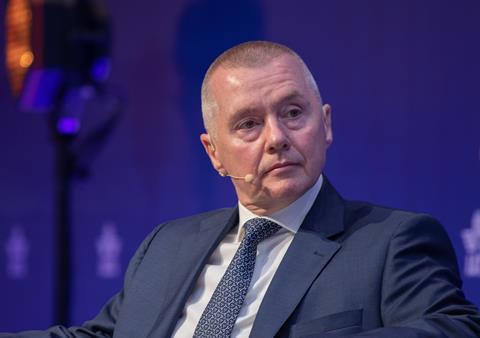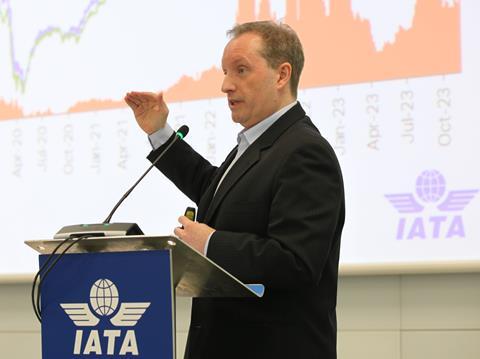Confirmation from IATA that the airline industry will return to collective profitability this year and that passenger volumes will shortly surpass pre-Covid levels is an indication that the sector has finally normalised.
While it probably won’t feel that way for the parts of the market still to fully recover, the industry is as a whole now approaching business-as-usual mode.

Airlines across three regions – North America, Europe and the Middle East – this year be profitable for the second time since the pandemic. Losses elsewhere in Asia-Pacific, Africa and Latin America have all narrowed.
Indeed the far quicker recovery than first anticipated among Asia-Pacific carriers – now seen reaching almost breakeven for the year – was a key factor in IATA upgrading its collective net profit estimate for 2023 to $23.3 billion. That is more than double its expectations for the year just six months ago.
”We identified a number of downside and upside risks,” explains IATA’s director, policy and economics, Andrew Matters, noting a key positive development that came through was China’s earlier-than expected lifting of strict Covid travel restrictions.
”We were surprised things came out better than we anticipated in terms of the strength of demand, a large part of that was how quickly China come back, particularly domestic China,” he says. ”And the downside risks we identified just didn’t materialise.”
That strong demand is reflected in a near $100 billion upgrade in revenue expectations. IATA had forecast industry revenues of just over $800 billion in its June forecast, but now expects collective airline turnover of $896 billion this year.
That is driven by strong passenger demand. Global traffic in October was within two percentage points of pre-Covid levels and across domestic markets has been running above 2019 levels since April.
GOOD YEAR, BUT FRUSTRATING
IATA director general Willie Walsh categorises the year as good, but flags airline frustrations over issues outside of their control. “We continue to see a lot of air traffic disruption – principally in the US and to a lessor degree in Europe. We had a lot of supply chain issues, which has significantly impacted the capacity that airlines would have wanted to have put into the market.
“Traffic growth during the year saw demand slightly outstripping capacity, but I think we would have seen more capacity coming into the market had these supply chain issues not impacted. [It’s] very disappointing to see the latest problem with the [Pratt & Whitney] GTF [engine] which will impact on airline capacity in 2024 and probably in 2025 based on the latest assessment we have.”
Walsh also flags the continuing challenges in accessing spare parts for aircraft both in service and undergoing maintenance, which is further crimping airline capacity – though plays its own part in keeping loads factors and yields high. ”So frustrating to see these issues, but in the main I think most of the industry is cautiously optimistic as we come to the end of 2023 and look forward to 2024,” he says.
IATA is forecasting only a modest rise in industry net profits for next year. While projecting an almost $9 billion improvement in industry operating profit in 2024 to $49.3 billion, it sees higher interest rates clipping the rise in total net profitability for the industry to just a little over $2 billion in reaching $25.7 billion.
AIRLINES MAKE MARGINAL GAINS
While the stronger return to profit after three pandemic-afflicted, loss-making years is certainly welcome, IATA though recognises the industry’s financial performance remains a work in progress, with net profit margins of 2.6% and 2.7% for this and next year respectively.
| Region | 2022 net profit estimate | 2023 net profit estimate | 2024 net profit forecast |
|---|---|---|---|
| Source: IATA Industry Outlook Dec 23 | |||
| North America | $9.1bn | $14.3bn | $14.4bn |
| Europe | $4.1bn | $7.7bn | $7.9bn |
| Middle East | $1.4bn | $2.6bn | $3.1bn |
| Asia-Pacific | ($13.6bn) | ($0.1bn) | $1.1bn |
| Africa | ($0.8bn) | ($0.5bn) | ($0.4bn) |
| Latin America | ($3.9bn) | ($0.6bn) | ($0.4bn) |
| Total | ($3.8bn) | $23.3bn | $25.7bn |
”In margin terms we are still significantly below where we need to be and significantly below where we were prior to the pandemic,” says Walsh. The industry was recording a net profit margins in excess of 4% during its long profit run in the last decade, including a 5% margin on net profits of $35 billion in 2017.
Matters notes: “What this really highlights is our industry remains a high volume, low margin business. There is still work in progress to ensure the industry going forward is financially sustainable.”

As a result he says there ”is not a lot of wriggle room there for airlines”. That leaves an industry, inherently at the mercy of external events, without much buffer against any further downside risks.
One of the major downside risks remains geopolitical issues, most recently compounded by fresh conflict in Israel. Walsh though notes that October data shows little impact at an aggregate level as Middle East airline traffic is still growing. ”So while it is impacting some individual airlines, when we look at the region we are not seeing any noticeable impact on traffic growth,” he says.
Neither does he see much change in the disruption stemming from Russia’s invasion of Ukraine last year.
”I don’t see Russian airspace opening in the foreseeable future and carriers in the region have made plans for the long-term closure of Russian airspace,” says Walsh. ”Had this happened 10 years ago, it would have had a very significant impact because most of the aircraft flying back then would not have had the range and payload capabilities to serve the market without a technical stop. That’s not the case today, the market is being served.”
Matters adds: ”One of the key challenges at the moment is certainly on the geopolitical side, it’s one of the things we are keeping a very close eye on. That of course is very difficult to quantify. But I think it’s fair to say that in recent years the level of geopolitical tensions globally has increased, it’s not just the Middle East, it’s not just Russia-Ukraine, I think there are some simmering tensions elsewhere.
”The world has become a bit more of an unfriendly place and that creates plenty of challenges for global industries such as aviation.”
He though notes geopolitical tensions are not the only risks it is looking at. ”We are also looking at some of the macro-economic risks; regulation around the world is another important source of risk.”
Overall IATA sees revenues climbing 7.6% in 2024. Not only would this take industry turnover to a new high of $964 billion, but it also outpaces an anticipated 6.9% rise in costs.
The industry’s financial performance in 2023 was helped by an easing in oil and jet fuel prices. ”Going forward our working assumption is its going to be a couple of dollars a barrel lower next year, but broadly similar to where we are now,” Matters says. ”So the good news is that we are not as high as we were last year, but we are still at a relatively high level.
While relatively low unemployment rates through the current financial cycle have been a notable positive for demand, he says the related additional wage pressure is an important consideration given how significant a part it is of airline operating costs.
“We often focus on the downsides, but we shouldn’t forget about the upside risks,” says Matters. That seems particularly apt given how the unexpectedly early reopening of China helped boost demand this year. That said, he acknowledges: ”On balance though I think it is fair to say the balance of risks around our forecast is still tilted toward the downside.
“It’s still a work in progress on the financial side and those downside risks could very well come into play. But overall cautiously optimistic on 2024, both in terms of traffic volumes and financial performance.”
















